Home | Front Page | Index | Blog | New | Contact | Site Map
Winter
Nazi Terror
Churches
Museums
Prussian palaces
Alte Stadt
Modern Architecture
Shopping
Quirks
Bei Uns (At Home)
Guests
Maps
Pics
Foto Show

Terror Museums
Terror Headquarters
Sachenhausen
Wannsee Conference
Resistance to Hitler
Jewish Museum
Phoenix Synagogue
Memorials
Travel 2005
Berlin
Paris
Moscow
Russia
Athens
Travel 2004
Mexico 2004
Belize
Guatemala
Honduras
Costa Rica
Panama
Colombia
Ecuador

Topography of Terror |

Sachsenhausen |

Wannsee Conference |
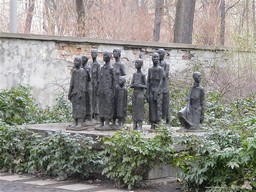
Memorials |
Nazi Terror and Jewish Life. So different and so connected. Adolf Hitler never hid his desire to rid Germany of all of its Jews. The world, and the Jews, and especially German Jews were not surprised by this. But they were suprised by the effort he and his evil regime put in to accomplish the eradication of those he hated.
We were not surprised by it either. But we were surprised to come to Berlin and find so much evidence of what went on. So many signs of repentance. So many signs that Hitler and his Nazi thugs did not win.
We present this tour in historical order rather than in the order we visited the sites mentioned. Hitler came to power in 1933 and shortly thereafter the Gestapo (an acronym for State Secret Police) was formed. The job of the Gestapo was to organize what it called security but what others more accurately experienced as terror, the arbitrary suppression of their political rights. One of the tools used in this terror was Sachsenhausen. Originally it was a beer factory but was taken over in 1936 by the Nazi's to imprison their active opponents. Later it became a staging post on the way to death camps and a death camp — half of the 200,000 who entered died there. At the Wannsee mansion a conference began on January 20, 1942 that laid out the guiding principles for completing the extermination of the Jews. At the end of this meeting no one in authority could any longer have doubted that death was the final goal. Resistance to Hitler existed even before he came to power. While he and his supporters saw him as a bulkwark against Bolshevik activism in Germany, the majority opposed both violent groups. But once he was in power and began his terror then survival for many required acting; thus were born some resistance groups.
After the war it became evident just how much evil Hitler and the Nazis had done and that they had not succeeded in their twin goals of a final solution and blotting out the memory of Jews. With the fall of the Berlin Wall in 1989 new opportunities arose for memorials. In the former East Berlin historic synagogues were repaired, a new Jewish museum was constructed, and a new memorial built to the millions of victims.
Topographie des Terrors: Controlling the Destruction

Topography of Terror - Gestapo Headquarters |
The Topographie des Terrors is an outdoor exhibit on the site of the former headquarters of Hitler's terror apparatus: the SS, the state police, the SS secret service, and so on. It is located just across the street from the former headquarters of the Reich Air Marshall and only a few blocks south of the modern British Embassy. The buildings occupied by this apparatus, including their kangaroo courts, were completly destroyed by wartime bombing and fighting.
As chance would have it part of the line between east and west Berlin passed down the street bordering the northern edge of the compound. The result was that the site lay fallow until reunification. Since then there have been several plans to build a large museum documenting the Nazi terror state, how it arose, how it was enforced, and who were its victims. So far each plan, even after considerable effort, has been rejected. Thus currently there is an exhibit, small but intense, that uses the former Berlin Wall as a backdrop.
It was here that we first learned about Hans and Sophie Scholl, a pair of students picked up in Munich for distributing anti-Nazi leaflets at the university and beheaded only days afterwards. Later in our stay we went to see a movie about the affair that was part of the Berlin Biennale, a film festival.
We found Typographie des Terrors so compelling that we visited it twice. The first time Jan nearly froze to her bones while reading the wall exhibits. The second time, with Sandro and Yvonne in tow, we managed to finish it. There is a book that contains all of the exhibited material and more, but reading it at home in warmth and comfort would not have been the same as taking in the terror where it happened.
Sachsenhausen: Beer Factory to Concentration Camp to Death Camp
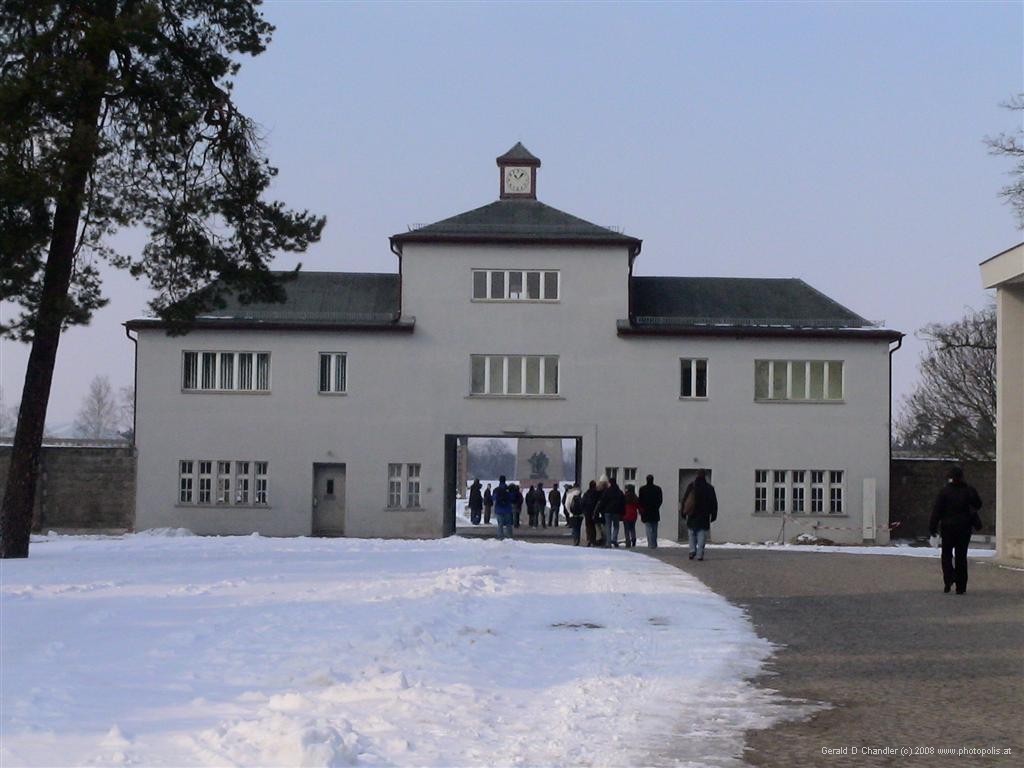
Main Entrance to Sachsenhausen Concentration Camp |
We were very glad to have Dinah and Mick visit us in Berlin as they are as much history buffs as we are. That meant that in spite of the bitter cold weather and the prospect of a mostly outdoor site, we still all agreed that we ought to visit Sachsenhausen, a concentration camp on the outskirts of Berlin.
Sachenhausen is a very small suburb on the east side of Oranienburg, itself about 34 kilometers north of Berlin. It is easy to imagine what it was like when it was a beer factory: the journey by train from Berlin passes through a mixture of housing, factories, and a bit of countryside that while undoubtedly changed since 1936 still gives the flavor: of people quietly going about their routines. Only once in Sachenhausen would a visitor really have an idea of the hardships being suffered.
In actuality there were many Sachenhausens: camps within camps and extensions of the camp and changes of use of the camp. During Hitler's years most political prisoners were held in the outer camp. Those who were to suffer the harshest, or who were kept there in extreme secret, were kept in special inner compounds. After the war the Soviet Union took over the place. At first it ran a prison that was as harsh as Hitlers. Years later it "rebuilt" the prison as a memorial both to those who died there and to "Soviet-German Anti_Fascist Friendship."
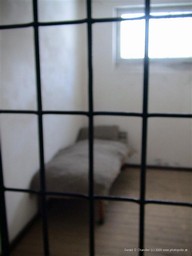
Sachsenhausen Prison Cell |
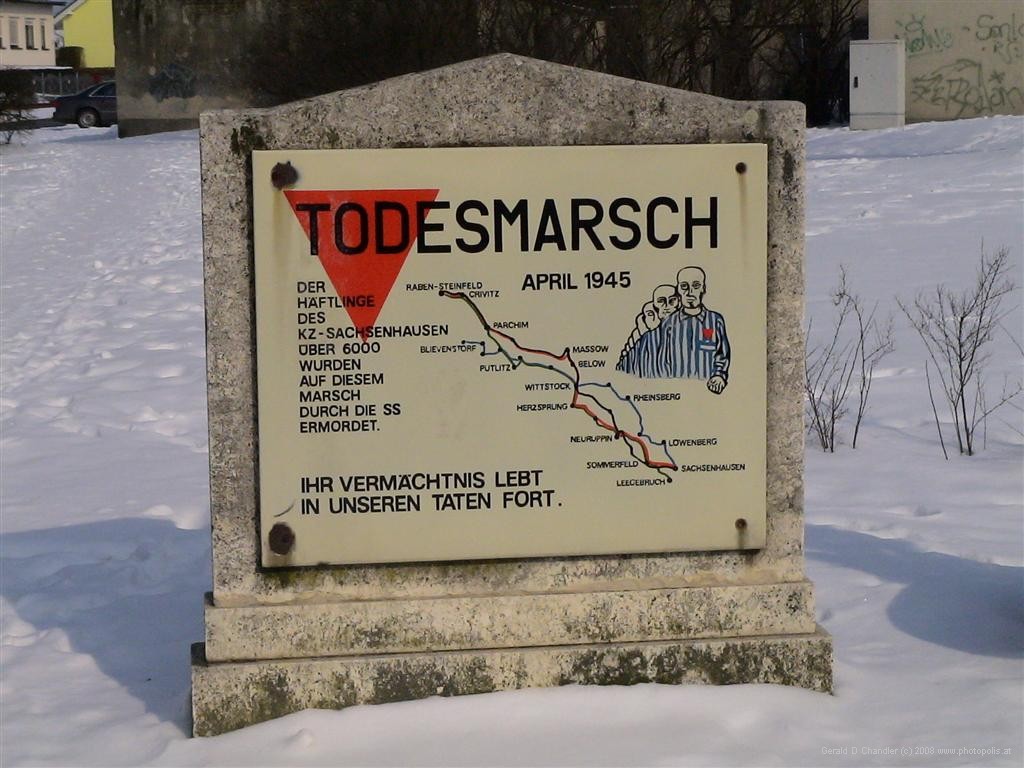
Death March from Sachenhausen |
We spent a long afternoon at the site, which still has some of the original buildings and some restoration from the Soviet changes. There is also quite a big museum with lots of information about the different kinds of people kept there. It was not an "industrial" death camp, but 100,000 people died nonetheless either from malnutrition, overwork, or both. Because the camp was in the former East Germany, there is also quite a bit of stuff about fraternal visits to the site from Communists the world over. No hint in the propaganda of the irony of one brutal regime condemning another. The site is pretty vast and dominated by a communist monument to the victims of the Nazi regime.
Sachsenhausen is not as ghoulish as the death camps of Poland, but there are many heart-wrenching stories nonetheless. There are also some heart-warming ones, such as that of the German priest in Berlin who absolutely refused to do business with the Nazis and was imprisoned for his pains for eight years. Perhaps if more of the church had taken such a stand, the people might have understood earlier the true nature of the regime that had taken over their country and done something about it.
Here in Jan's words is a view we both share: "Perhaps I'll take this opportunity to say that in my view that is the lesson that George Bush, Tony Blair, and allies have taken to heart with respect to terrorism. It is an evil scourge and must be eradicated. Standing back and hoping that by saying nothing your country will be immune is just not true. How goes the saying: "When they came for the Jews I said nothing. When they came for the Gypsies, I said nothing. When they came for the Communists, I said nothing. When they came for me there was nobody left to say anything." I should perhaps add that I am writing this shortly after the terrorist attacks in London and know that Gerry and I might have been victims of that attack in slightly different circumstances."
Each of us toured the site in our own ways. Dinah and Mick took English audio guides. Jan took a German one but ended up prefering to read. Gerry just skipped the guide and read. By the end of the day, we were all pretty chilled and happy to climb back onto the train and make our way back to the big city for a nice dinner.
Wannsee Conference "Final Solution"
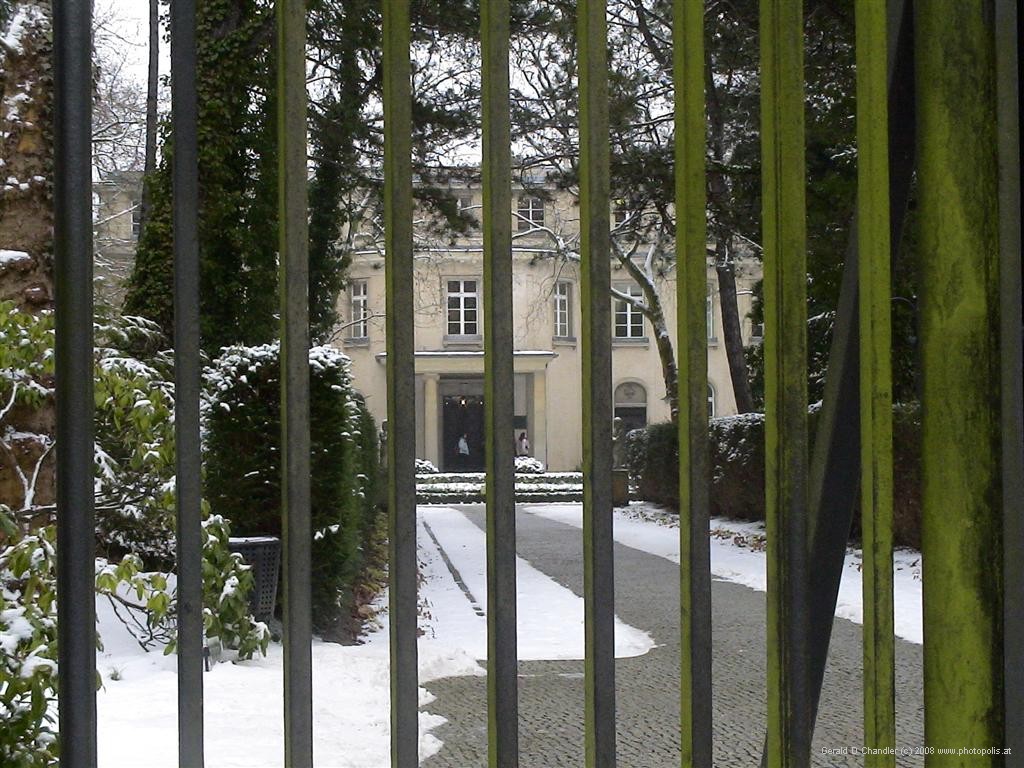
Wannsee Estate Behind Gates |
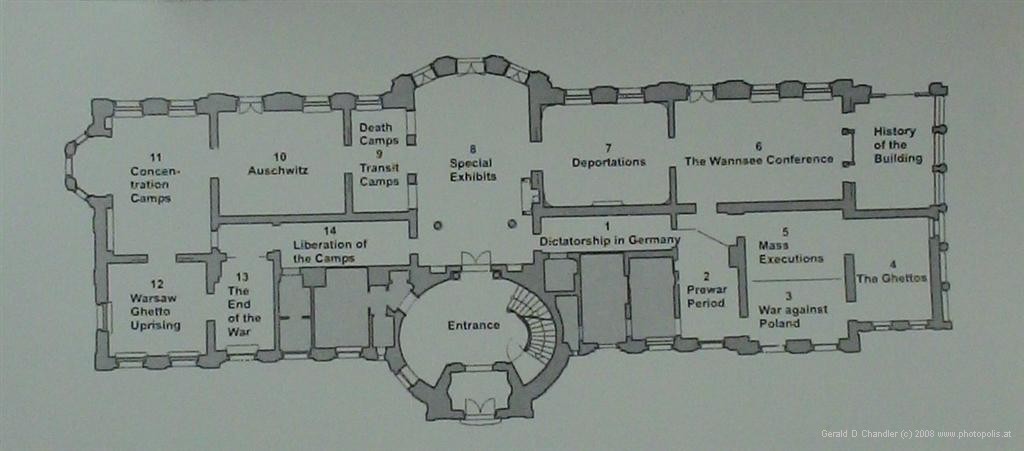
House Plan with Museum Uses of Rooms |
The Wannsee is a large lake formed by the Havel River. Now on the edge of built-up Berlin, pre-war and modern Berliners like to have summer homes on the lake if they can afford it and if not like to come for the day to enjoy various water sports or just spend a day on the beach. In the early 1920s a German industrialist who made a fortune on beer built himself a mansion here. A decade later he solved legal problems over taxes by donating the house to the Nazi Party, of which he was already a supporter. After another decade of various uses, mostly luxurious ones for Party big-wigs, it was used for a few days for a purpose which made it infamous: it became the house where the Nazi regime plotted the details of the "final solution" to the so-called Jewish problem.
Our visit to Wannsee was a bit of a numbing experience. It was made even more so because of the fact that we had seen a re-enactment of the Wannsee Conference on film and so could literally see in our minds eye the people involved and the horrific seriousness and yet mundanity with which they set about planning the so-called "final solution", the brutal murder of literally millions of Jewish men, women, and children. It does not bear description and yet described it must be, over and over again, from generation to generation, in an unending effort to prevent it from ever happening again.
We spent a couple of hours there, re-learning the antecedents to the crime, learning more about the participants and finding out about the small pockets of resisters that did exist and learning their, mostly unhappy, fate. There is also quite a bit about the attempt on Hitler's life, led by von Stauffenberg and his allies which sadly failed. The museum has lots of original documents on display about the assassination attempt and the preparations that were made. They include lists of people who were to take over various posts in the government and administration of the country which Gerry, in particular, found quite fascinating. He wondered how they managed to keep it secret given the number of people involved.
Jan was interested to see a group of young Germans being taken around the museum. At first she thought it was a school group but later concluded that they were a group of young delinquents of some kind who must have had some kind of history project to do. She wished she could have eavesdropped a bit more but they were moving through the museum much faster than we were. That made her wonder what place all of these museums play in German education these days. If you live in or around Berlin, do you take at least one school trip to Sachsenhausen, to Wannsee, or to the Typographie des Terrors? And if the answer is yes, what impression do the kids take away with them?
Resistance to Hitler
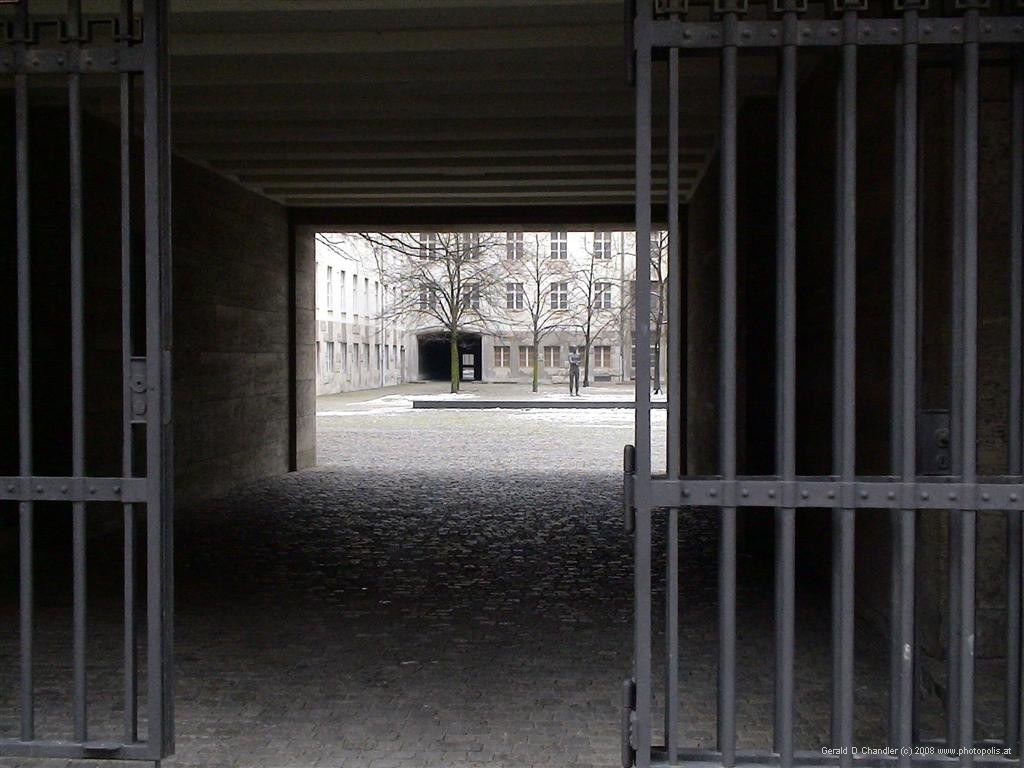
Entry to the Widerstand (Resistance) Museum |

Sophie Scholl Advertisement |
Hitler was democratically elected but immediately upon his taking office he began, successfully, to subvert democracy. To those who opposed him before he took power there were added more and more. Some of these people are what we would call "nobodies" - people without office and few resources who were determined to do what they could. Others were at the other end of the spectrum, high ranking officials who opposed him, some out of conscience and some out of worry over the disasters that Hitler had caused and was causing.

Yorck Tickets |
The story of the resistance is told in the Widerstandsmuseum. It is housed in the building that was once Army headquarters in Berlin. One part of the story is told in the very rooms where it started: how a group of high ranking officers plotted to kill Hitler and assume power; without him they planned to have a conditional surrender that would maintain Germany as unoccupied, undefeated. We can hardly admire their long-term goals, but we can wish that they had been suicide bombers. If Claus von Stauffenberg had remained with the bomb he planted in Hitler's "Wolf's Lair" (at Rastenberg where Hitler was meeting his generals) it would not have been moved aside and Hitler most likely would have succumbed.
The movie "Sophie Scholl - The Last Days" was released in conjunction with the Berlin Biennale (or Film Festival), which opened in the first few weeks of our stay in Berlin. The movie tells how Sophie and her brother, students at Munich University, were secretly distributing anti-Nazi litterature calling on the University community to resist Hitler and the Nazis. One distribution went wrong and they were caught. By the laws of the day they were guilty of sedition. Tried, they were convicted and within days guillotined. We saw it in the Yorck movie theatre, a 15 minute walk from out apartment. As far as we could tell the mostly German audience had the same reaction as us: silent horror and a wish these things had never happened.
Jewish Museum: A Heritage Not Forgotten
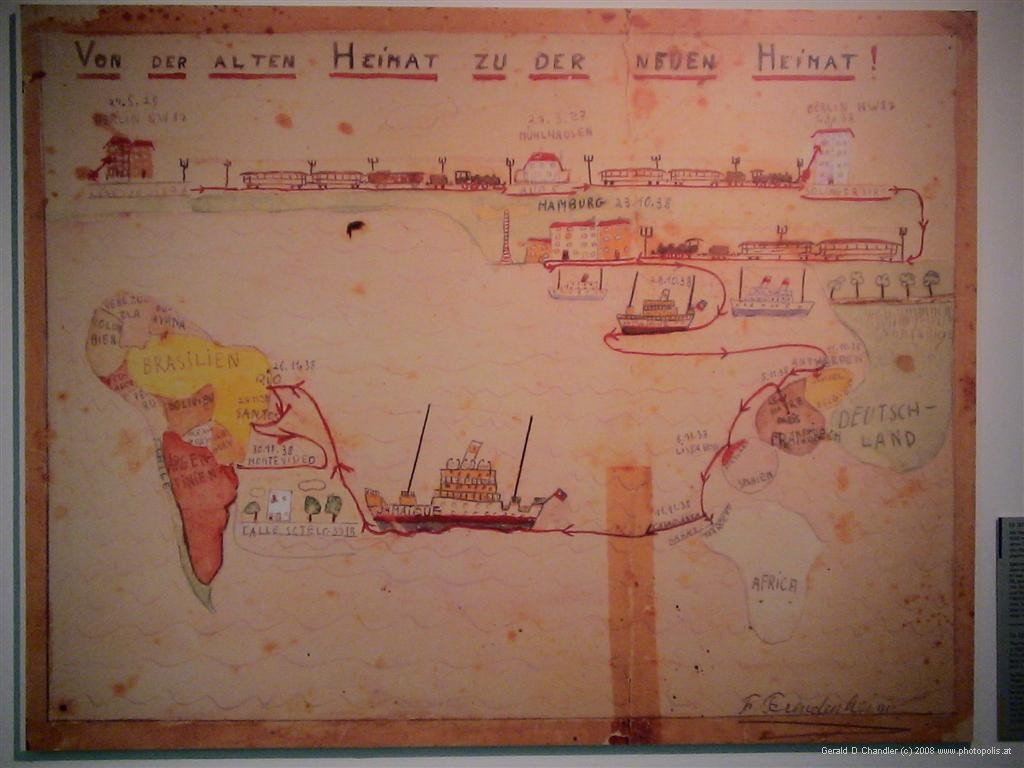
The Jew must Wander - A boy leaves Germany |
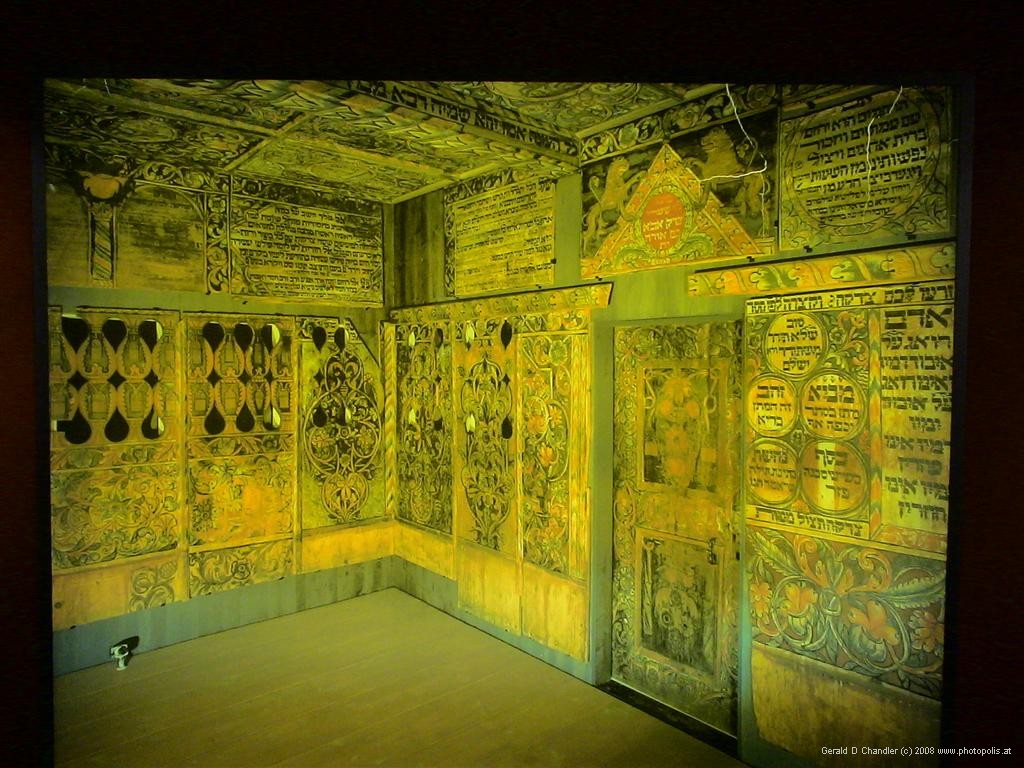
Interior of Destroyed Synagogue |
Another whole day was devoted to the museum of Jewish History. Not a holocaust museum, this collection tells the story of the Jews of Germany before, during, and after the Second World War. It talks about how Jews migrated to Germany over the years and how they contributed to the enlightenment. It tells the stories of famous German-Jewish musicians like Mendelsohn and Mahler. It talks about famous German-Jewish scientists and philanthropists, bankers and businessman. It also talks about the holocaust and about how difficult it was for this middle-class, assimilated group of Jews to understand and accept what was happening to them.
The museum is housed in two connected buildings, a reaonably short walk south-east of Checkpoint Charlie. The bigger, newer building houses the exhibits on about four floors. The tour begins by entering the older, smaller building, where the reception, bookstore, restaurant, etc are located and taking a tunnel to the exhibit building. There one climbs to the top and works one's way down, passing through centuries of Jewish history. We liked the older, rococo building and were not at all impressed with the modern, shinny-metal clad new building. But once inside the exhibits are absorbing. We should add that the architect of the Jewish Museum's new building is none other than Daniel Liebeskind, now more famous for having the winning design in the competition to replace the World Trade Center, New York. Having seen his work in vivo, we sort of hope his design doesn't get built.
Synagogues and Jewish Life Reborn
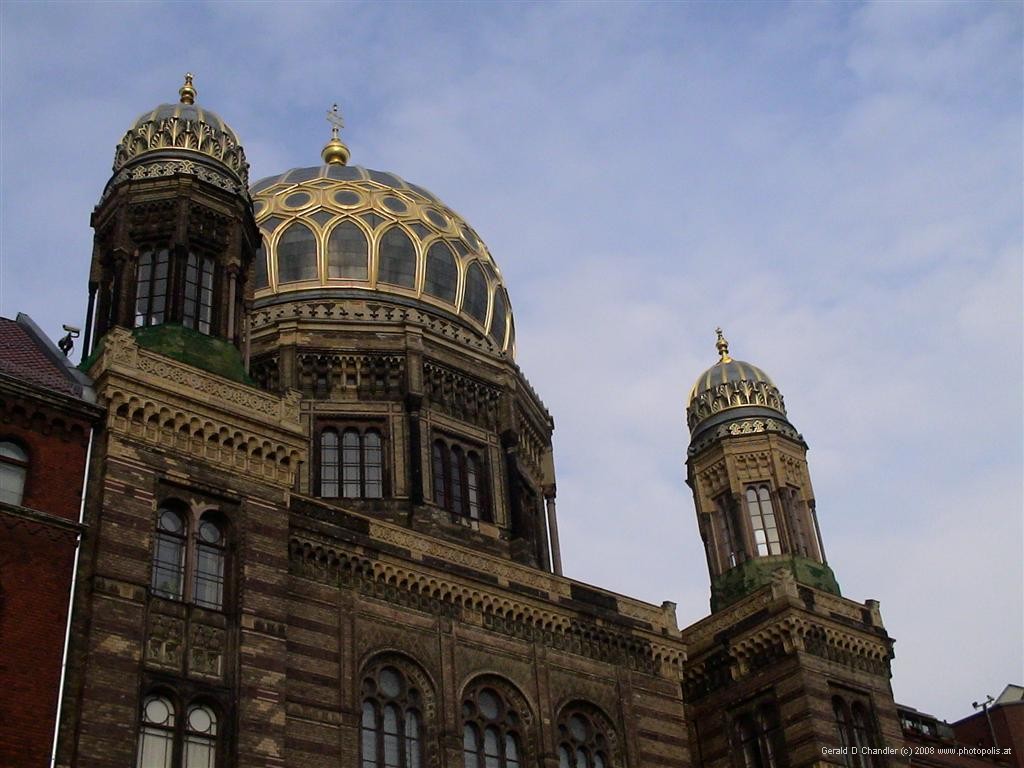
The Phoenix Synagogue |
Once there were many synagogues in Berlin. On "Kristallnacht" in 1938 that ended. But a few were saved, only to burn during the war. With reunification there was no longer an atheist regime impeding reconstruction. As with so many other parts of the former Soviet empire some of the synagogues have been lovingly rebuilt and restored.
Memorials: They shall not be forgotten

Jewish Ghosts |
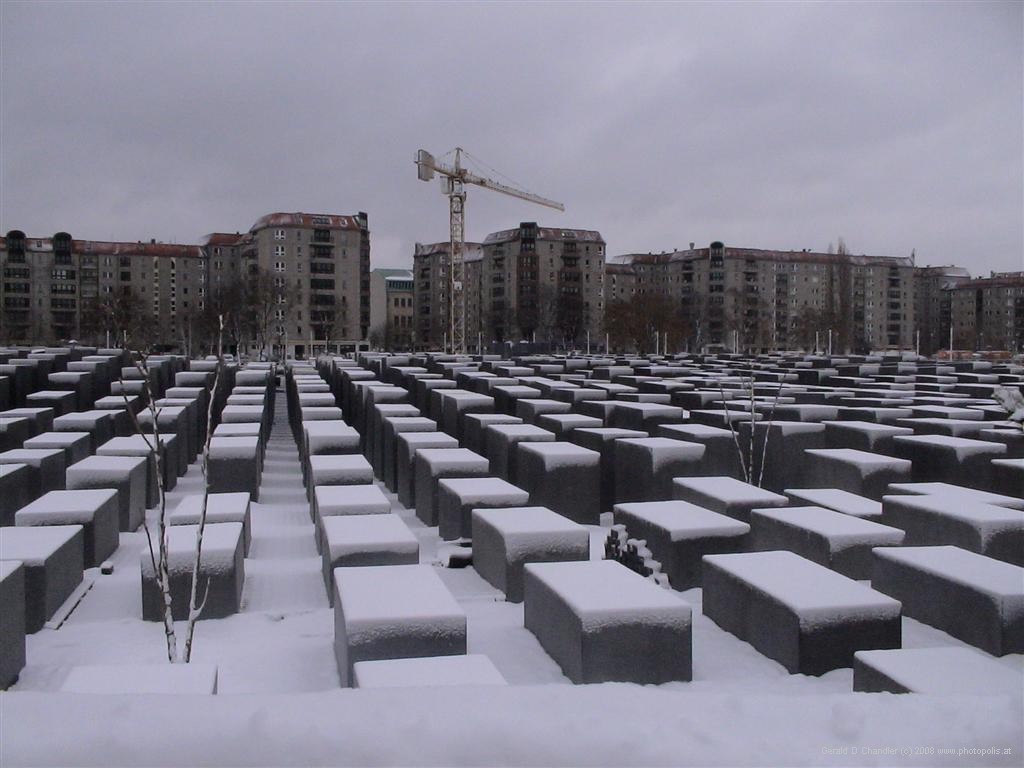
Memorial to the Millions |
We did not get to visit the Memorial to the victims of the Nazi regime but we did get to see it from afar. Gerry was somewhat impressed, Jan hated it. Lots of square blocks that express none of the pain and the sorrow and the sheer humanity of those whom Hitler destroyed.
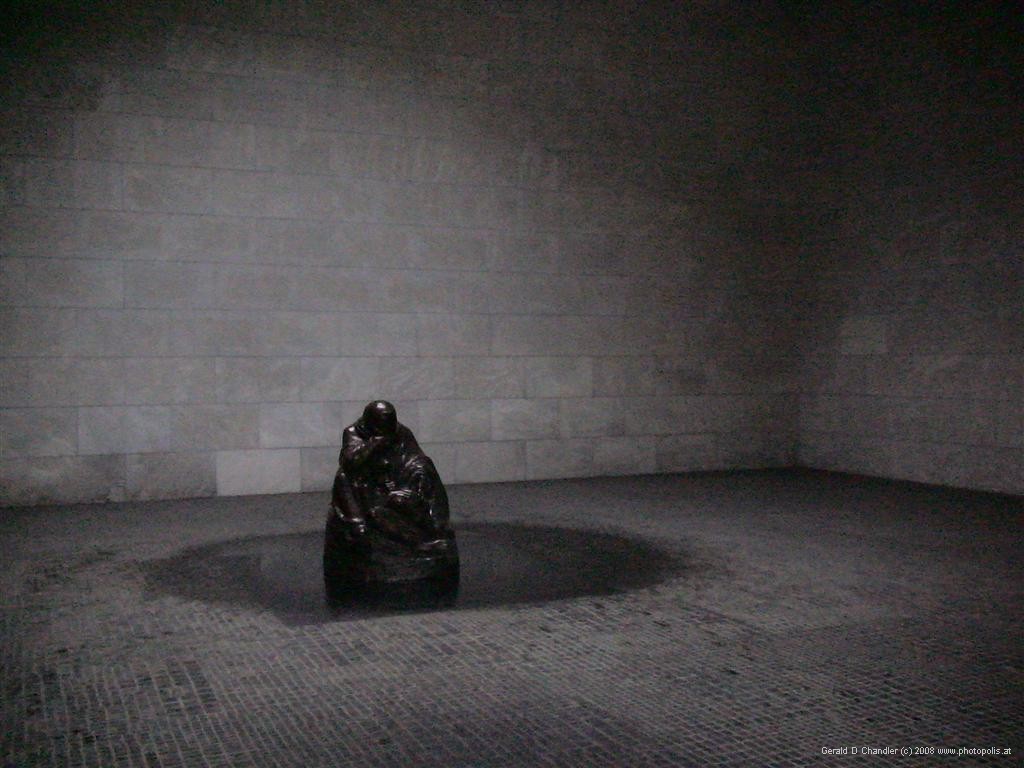
Remembering the German dead |
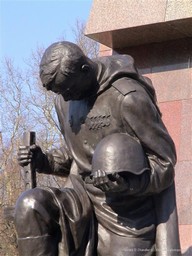
Remembering the Soviet Dead |
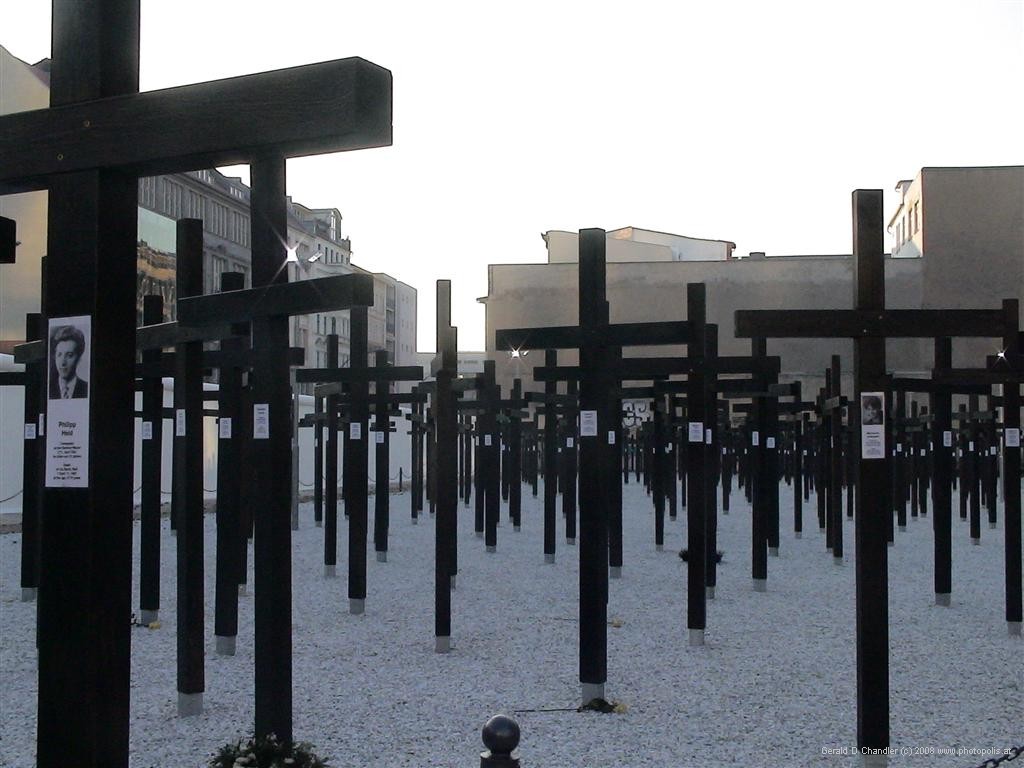
Memorial to the Dead who tried to Flee East Germany |
The end of Hitler's rule did not end the trouble's of Berlin's people. In 1945 half of the city became the Soviet Sector and in 1960 with the construction of the Berlin Wall it became the "East". Thousands wanted to flee the represive system and many died in the attempt. This memorial of crosses was a private, non-government sponsored affair. It is along the trace of the old wall, hardly 50 meters from the old Checkpoint Charlie. We passed by several times. On the first we spoke to a man who was the main sponsor. He had a petition asking the government not to evict him and to not sell the plot for re-development. A month later, at the end of our stay, we read that the government had evicted him and was going ahead with its plans.